W/WO3/TiO2 Multilayer Film with Elevated Electrochromic and Capacitive Properties
Abstract
1. Introduction
2. Materials and Methods
3. Results and Discussion
4. Conclusions
Author Contributions
Funding
Institutional Review Board Statement
Informed Consent Statement
Data Availability Statement
Conflicts of Interest
References
- Wang, L.J.; El-Kady, M.F.; Dubin, S.; Hwang, J.Y.; Shao, Y.; Marsh, K.; McVerry, B.; Kowal, M.D.; Mousavi, M.F.; Kaner, R.B. Flash converted graphene for ultra-high power supercapacitors. Adv. Energy Mater. 2015, 5, 1500786. [Google Scholar] [CrossRef]
- Liu, Z.; Liu, S.; Dong, R.; Yang, S.; Lu, H.; Narita, A.; Feng, X.; Müllen, K. High power in-plane micro-supercapacitors based on mesoporous polyaniline patterned graphene. Small 2017, 13, 1603388. [Google Scholar] [CrossRef] [PubMed]
- Wei, D.; Scherer, M.R.J.; Bower, C.; Andrew, P.; Ryhänen, T.; Steiner, U. A nanostructured electrochromic supercapacitor. Nano Lett. 2012, 12, 1857–1862. [Google Scholar] [CrossRef] [PubMed]
- Cheng, G.; Xu, J.; Dong, C.; Yang, W.; Kou, T.; Zhang, Z. Anodization driven synthesis of nickel oxalate nanostructures with excellent performance for asymmetric supercapacitors. J. Mater. Chem. A 2014, 2, 17307–17313. [Google Scholar] [CrossRef]
- Wang, C.; Bai, L.; Zhao, F.; Bai, L. Activated carbon fibers derived from natural cattail fibers for supercapacitors. Carbon Lett. 2022, 32, 907–915. [Google Scholar] [CrossRef]
- Thillaikkarasi, D.; Karthikeyan, S.; Ramesh, R.; Sengodan, P.; Kavitha, D.; Muthubalasubramanian, M. Electrochemical performance of various activated carbon-multi-walled carbon nanotubes symmetric supercapacitor electrodes in aqueous electrolytes. Carbon Lett. 2022, 32, 1481–1505. [Google Scholar] [CrossRef]
- Liu, K.; Yu, C.; Guo, W.; Ni, L.; Yu, J.; Xie, Y.; Wang, Z.; Ren, Y.; Qiu, J. Recent research advances of self-discharge in supercapacitors: Mechanisms and suppressing strategies. J. Energy Chem. 2021, 58, 94–109. [Google Scholar] [CrossRef]
- Bello, I.T.; Oladipo, A.O.; Adeokn, O.; Dhlamini, S.M. Recent advances on the preparation and electrochemical analysis of MoS2-basedmaterials for supercapacitor applications: A mini-review. Mater. Today Commun. 2020, 25, 101664. [Google Scholar] [CrossRef]
- Pham, H.D.; Chodankar, N.R.; Jadhav, S.D.; Jayaramulu, K.; Nanjundan, A.K.; Dubal, D.P. Large interspaced layered potassium niobate nanosheet arrays as an ultrastable anode for potassium ion capacitor. Energy Storage Mater. 2021, 34, 475–482. [Google Scholar] [CrossRef]
- Wang, J.; Zhang, L.; Yu, L.; Jiao, Z.; Xie, H.; Lou, X.W.; Sun, X.W. A bi-functional device for self-powered electrochromic window and self-rechargeable transparent battery applications. Nat. Commun. 2014, 5, 4921. [Google Scholar] [CrossRef]
- Bayrak, P.İ.; Atak, G.; Niklasson, G.A.; Stolt, L.; Edoff, M.; Edvinsson, T. Electrochromic solar water splitting using a cathodic WO3 electrocatalyst. Nano Energy 2021, 81, 105620. [Google Scholar] [CrossRef]
- Bi, Z.; Li, X.; He, X.; Chen, Y.; Xu, X.; Gao, X. Integrated electrochromism and energy storage applications based on tungsten trioxide monohydrate nanosheets by novel one-step low temperature synthesis. Sol. Energy Mater. Sol. Cells 2018, 183, 59–65. [Google Scholar] [CrossRef]
- Yang, P.; Sun, P.; Mai, W. Electrochromic energy storage devices. Mater. Today 2016, 19, 394–402. [Google Scholar] [CrossRef]
- Zhou, S.; Wang, S.; Zhou, S.; Xu, H.; Zhao, J.; Wang, J.; Li, Y. Electrochromic-Supercapacitor Based on MOF Derived Hierarchical-Porous NiO Film. Nanoscale 2020, 12, 8934–8941. [Google Scholar] [CrossRef] [PubMed]
- Wei, H.; Zhu, J.; Wu, S.; Wei, S.; Guo, Z. Electrochromic polyaniline/graphite oxide nanocomposites with endured electrochemical energy storage. Polymer 2013, 54, 1820–1831. [Google Scholar] [CrossRef]
- Zhong, Y.; Chai, Z.; Liang, Z.; Sun, P.; Xie, W.; Zhao, C.; Mai, W. Electrochromic Asymmetric Supercapacitor Windows Enable Direct Determination of Energy Status by the Naked Eye. ACS Appl. Mater. Interfaces 2017, 9, 34085–34092. [Google Scholar] [CrossRef] [PubMed]
- Chen, J.; Wang, Z.; Chen, Z.; Cong, S.; Zhao, Z. Fabry-Perot Cavity-Type Electrochromic Supercapacitors with Exceptionally Versatile Color Tunability. Nano Lett. 2020, 20, 1915–1922. [Google Scholar] [CrossRef]
- Park, S.; Thuy, D.T.; Sarwar, S.; Van Tran, H.; Lee, S.I.; Park, H.S.; Song, S.H.; Han, C.-H.; Hong, S. Synergistic effects of Ti-doping induced porous networks on electrochromic performance of WO3 films. J. Mater. Chem. C 2020, 8, 17245–17253. [Google Scholar] [CrossRef]
- Han, J.; Ko, K.-W.; Sarwar, S.; Lee, M.-S.; Park, S.; Hong, S.; Han, C.-H. Enhanced electrochromic properties of TiO2 nanocrystal embedded amorphous WO3 films. Electrochim. Acta 2018, 278, 396–404. [Google Scholar] [CrossRef]
- Sun, X.; Wang, D.; Wu, W.; Zhao, X.; Zhang, X.; Wang, B.; Rong, X.; Wu, G.; Wang, X. Amorphous and Crystalline Ti-Doped WO3·2H2O for Dual-Band Electrochromic Smart Windows. ACS Sustain. Chem. Eng. 2024, 12, 5459–5467. [Google Scholar] [CrossRef]
- Liu, L.; Zhang, Q.; Du, K.; He, Z.; Wang, T.; Yi, Y.; Wang, M.; Zhong, X.; Dong, G.; Diao, X. An intelligent and portable power storage device able to visualize the energy status. J. Mater. Chem. A 2019, 7, 23028–23037. [Google Scholar] [CrossRef]
- Reyes-Gil, K.R.; Stephens, Z.D.; Stavila, V.; Robinson, D.B. Composite WO3/TiO2 nanostructures for high electrochromic activity. ACS Appl. Mater. Interfaces 2015, 7, 2202–2213. [Google Scholar] [CrossRef] [PubMed]
- Wang, Z.; Wang, X.; Cong, S.; Chen, J.; Sun, H.; Chen, Z.; Song, G.; Geng, F.; Chen, Q.; Zhao, Z. Towards full-colour tunability of inorganic electrochromic devices using ultracompact fabry-perot nanocavities. Nat. Commun. 2020, 11, 1–9. [Google Scholar] [CrossRef] [PubMed]
- Yang, P.; Sun, P.; Chai, Z.; Huang, L.; Cai, X.; Tan, S.; Song, J.; Mai, W. Large-scale fabrication of pseudocapacitive glass windows that combine electrochromism and energy storage. Angew. Chem. Int. Ed. Engl. 2014, 53, 11935–11939. [Google Scholar] [CrossRef] [PubMed]
- Zhu, M.; Huang, Y.; Huang, Y.; Meng, W.; Gong, Q.; Li, G.; Zhi, C. An electrochromic supercapacitor and its hybrid derivatives: Quantifiably determining their electrical energy storage by an optical measurement. J. Mater. Chem. A 2015, 3, 21321–21327. [Google Scholar] [CrossRef]
- Guo, X.; Zhang, C.; Mi, S.; Li, M.; Han, Z.; Tang, X.; Zhang, T.; Chen, Y.; Wang, X.; Wang, C.; et al. Realizing Flexible Multicolored Electrochromism on Carbon Nanotubes through Thin-Film Interference. ACS Photonics 2024, 11, 2335–2341. [Google Scholar] [CrossRef]

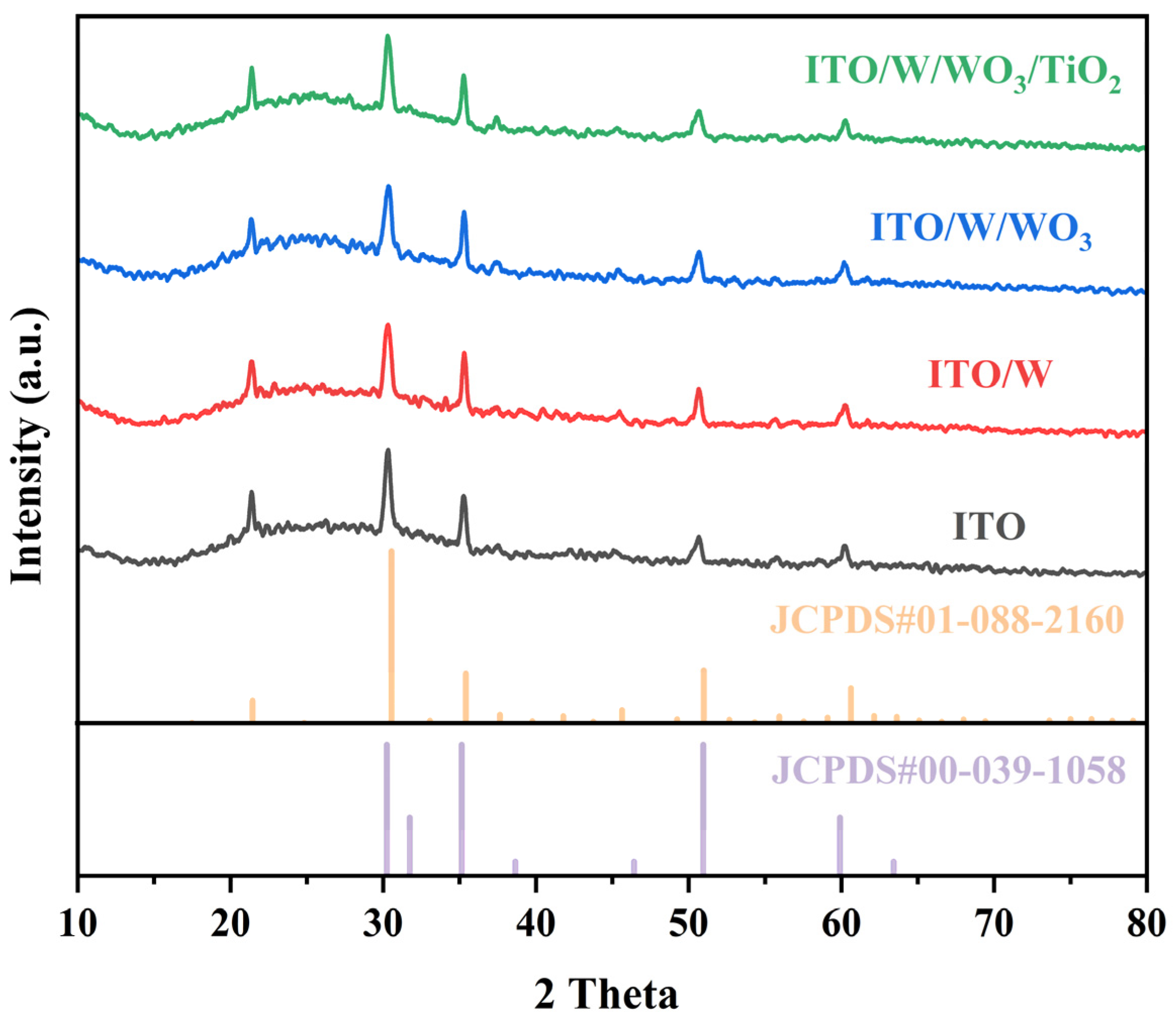


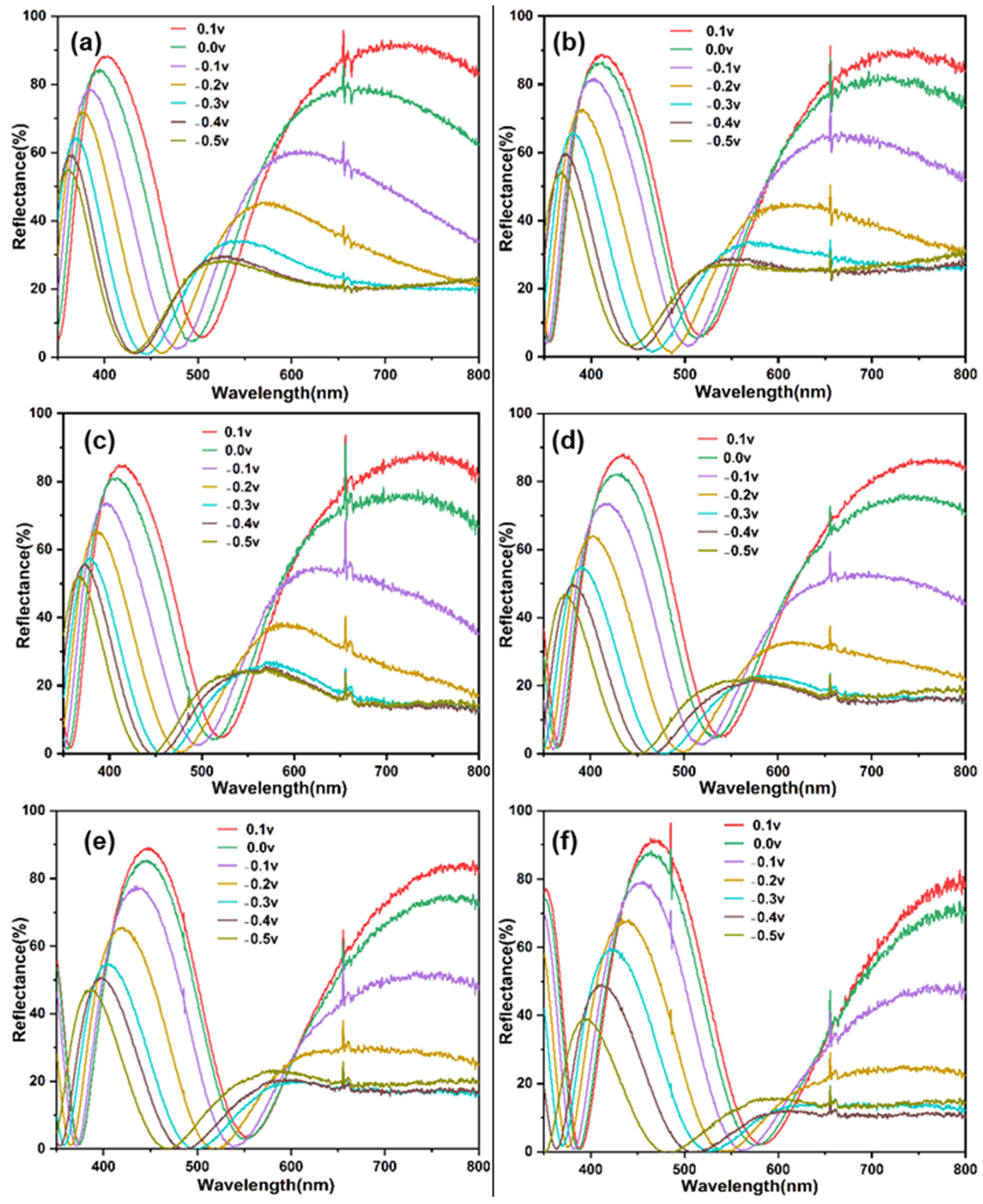

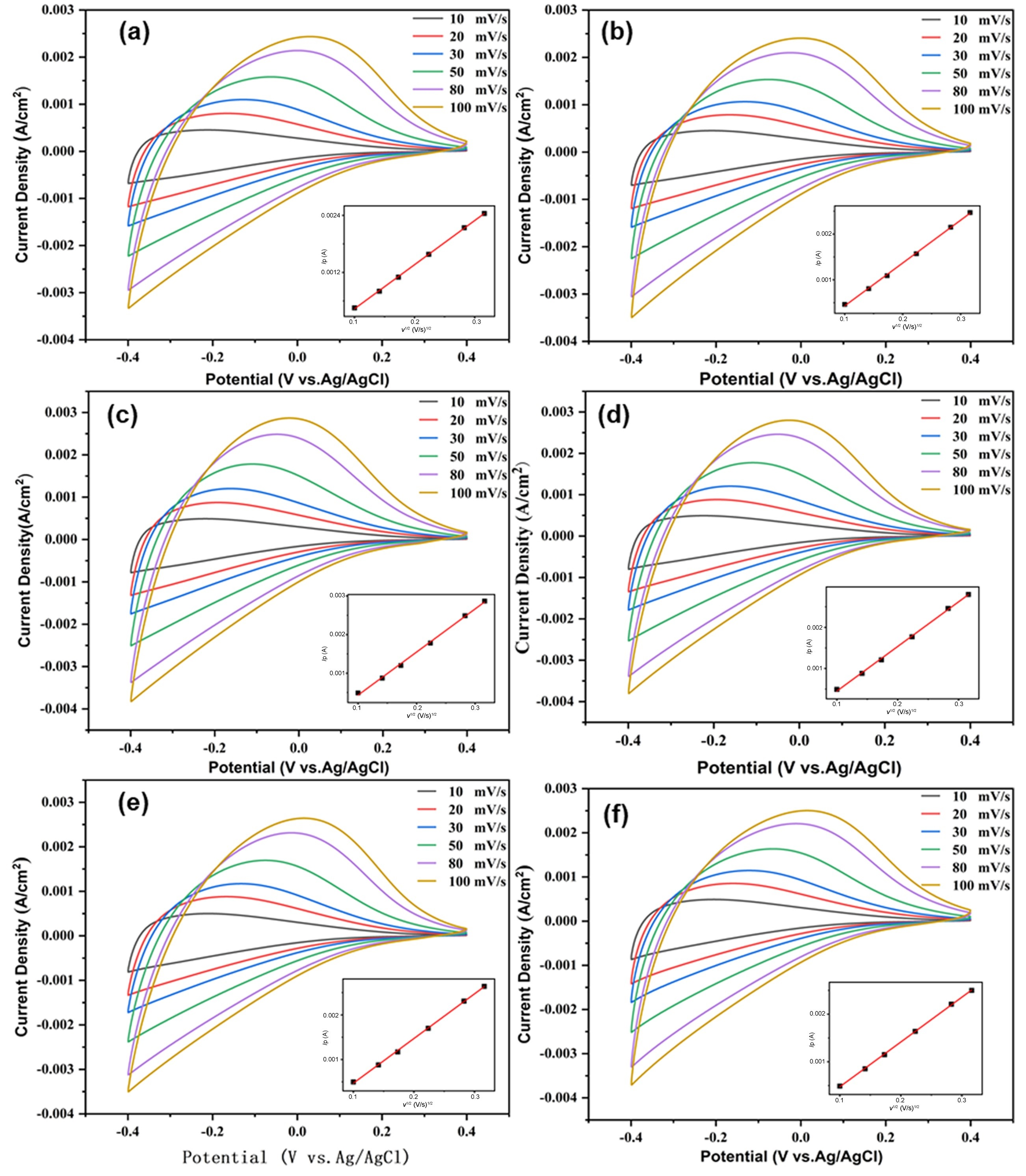
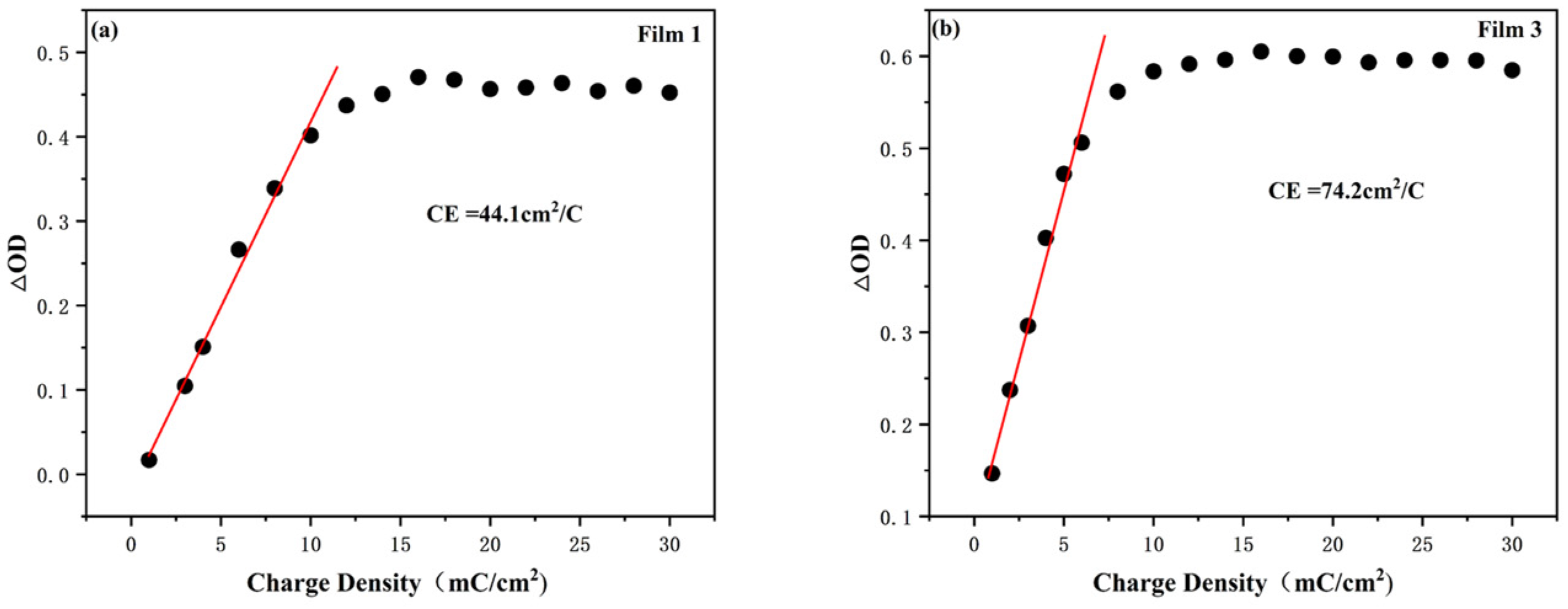
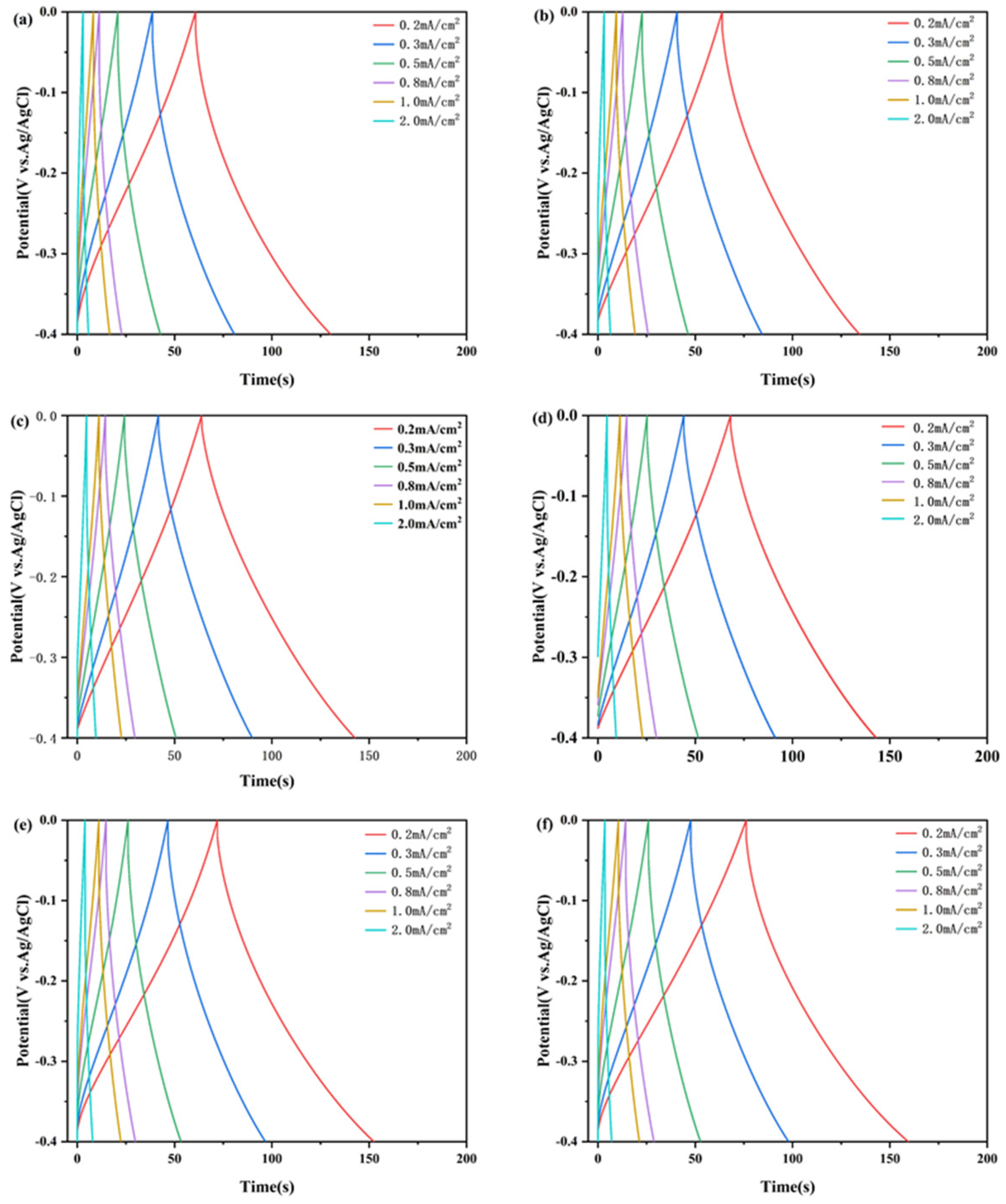

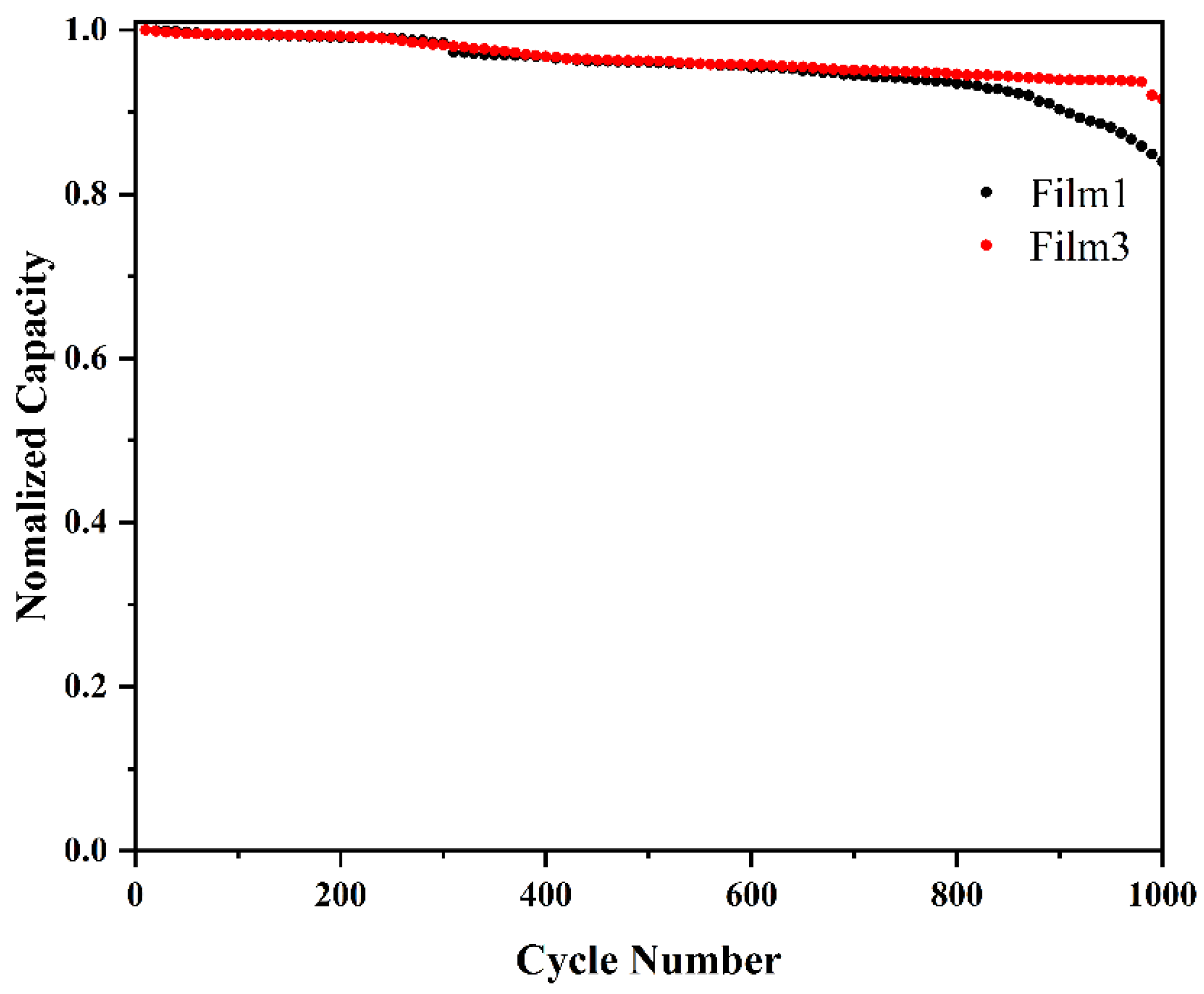
Disclaimer/Publisher’s Note: The statements, opinions and data contained in all publications are solely those of the individual author(s) and contributor(s) and not of MDPI and/or the editor(s). MDPI and/or the editor(s) disclaim responsibility for any injury to people or property resulting from any ideas, methods, instructions or products referred to in the content. |
© 2025 by the authors. Licensee MDPI, Basel, Switzerland. This article is an open access article distributed under the terms and conditions of the Creative Commons Attribution (CC BY) license (https://creativecommons.org/licenses/by/4.0/).
Share and Cite
Wang, Z.; Liu, G.; Li, C.; Qiao, M.; Tian, M.; Lin, X.; Cui, W.; Wang, X.; Liu, J.; Xu, S. W/WO3/TiO2 Multilayer Film with Elevated Electrochromic and Capacitive Properties. Materials 2025, 18, 161. https://doi.org/10.3390/ma18010161
Wang Z, Liu G, Li C, Qiao M, Tian M, Lin X, Cui W, Wang X, Liu J, Xu S. W/WO3/TiO2 Multilayer Film with Elevated Electrochromic and Capacitive Properties. Materials. 2025; 18(1):161. https://doi.org/10.3390/ma18010161
Chicago/Turabian StyleWang, Zhenxing, Guofeng Liu, Chonghui Li, Mei Qiao, Meng Tian, Xiaohui Lin, Wanling Cui, Xiaoxin Wang, Jinhai Liu, and Shicai Xu. 2025. "W/WO3/TiO2 Multilayer Film with Elevated Electrochromic and Capacitive Properties" Materials 18, no. 1: 161. https://doi.org/10.3390/ma18010161
APA StyleWang, Z., Liu, G., Li, C., Qiao, M., Tian, M., Lin, X., Cui, W., Wang, X., Liu, J., & Xu, S. (2025). W/WO3/TiO2 Multilayer Film with Elevated Electrochromic and Capacitive Properties. Materials, 18(1), 161. https://doi.org/10.3390/ma18010161





